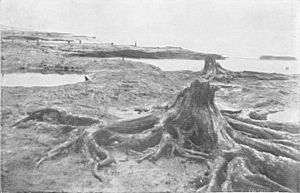Clement Reid facts for kids
Clement Reid (born January 6, 1853 – died December 10, 1916) was a British geologist and palaeobotanist. He studied ancient plants and how the Earth has changed over time. He is best known for his ideas about a lost land bridge that once connected Britain to Europe.
Contents
About Clement Reid's Life
Clement Reid was born in London in 1853. He was related to the famous scientist Michael Faraday. Clement mostly taught himself, but he was very good at geology. In 1874, he joined the Geological Survey of Great Britain. This job involved drawing detailed maps of the Earth's surface in different parts of the country.
He became a Geologist in 1894 and a District Geologist in 1901. He retired from his work in 1913.
His Important Discoveries
Clement Reid was very interested in ancient geological layers and the fossils found within them. He became famous for his work on quaternary and Pliocene deposits. These are types of rock layers that formed millions of years ago. He often worked with his wife, Eleanor, especially in Norfolk, England.
He received several awards for his scientific work. These included The Murchison Fund in 1886 and the Bigsby Medal in 1897. He also became a member of important scientific groups. He was elected a Fellow of the Geological Society in 1875. Later, he was the vice-president of the Geological Society of London from 1913 to 1914. In 1888, he became a Fellow of the Linnean Society.
In 1899, Clement Reid was elected a Fellow of the Royal Society. This is a very high honor for scientists. People recognized his important contributions to geology. He greatly improved our understanding of ancient rock formations. For example, he studied the Pliocene deposits in Norfolk. He also looked at the Cromer Forest Bed, which contains fossils of plants and animals from a very long time ago.
Clement Reid also studied ancient seeds and plants. This helped scientists learn about the climate conditions from long ago. It also helped them understand how British plants came to be.
Studying Ancient Roman Towns
From 1899 to 1909, Clement Reid helped analyze plant remains from the ancient Roman town of Silchester. This work helped historians understand what plants people used and grew in Roman times.
The Lost Land of Doggerland
In 1913, Clement Reid published a book called "Submerged Forests". In this book, he suggested that there was once a land bridge between eastern England and mainland Europe. He thought this land was now underwater. He even drew a map of this lost land.
Today, we call this area "Doggerland". Scientists now know that Reid's map was very close to what Doggerland actually looked like. It was a real place that connected Britain to Europe thousands of years ago.
Clement Reid passed away in 1916 in Milford-on-Sea, Hampshire. He had married Eleanor Mary Wynne Edwards in 1897. After his death, Eleanor continued her own important geological work. She even won the Lyell Medal for her contributions.



